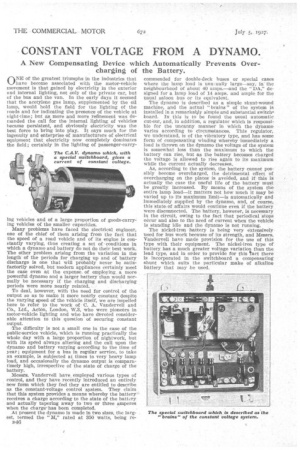• CONSTANT VOLTAGE FROM A DYNAMO.
Page 100

If you've noticed an error in this article please click here to report it so we can fix it.
A New Compensating Device which Automatically Prevents Overcharging of the Battery.
(-11\TE of the greatest triumphs in the industries that I....It-lave become associated with the motor-vehicle movement is that gained by electricity in the exterior and internal lighting, not only of the private car, but of the bus and the van. In the early days it seemed that the acetylene gas lamp, supplemented by the oil lamp, would hold the field for the lighting of the oads and for indicating the presence of the vehicle at night-time; but as more and more refinement was demanded the call for the internal lighting of vehicles became persistent, and obviously electricity was the best force to bring into play. It says much for the ingenuity and enterprise of manufacturers of electrical equipment that electricity now completely dominates the field; certainly in the lighting of passenger-carry
ing vehicles and of a large proportion of goods-carrying vehicles of the smaller capacities.
Many problems have faced the electrical engineer, one of the chief of them arising from the fact that the speed of a road vehicle and of its engine is constantly varying, thus creating a set of -conditions in which a dynamo and battery do not do their best work. The other problem arising from the variation in the length of the periods for charging up and of battery discharge is one that will probably never be satisfactorily solved, but modern appliances certainly meet the case even at the expense, of employing a more powerful dynamo and a larger battery-than would normally be necessary if the charging and discharging periods were more nearly related.
To deal, however, with the need for control of the output so as to make it more nearly constant despite the 'Varying speed of the vehicle itself, we are impelled here to .refer to the work of C. A. Vandervell and Co., Ltd., Actbn, London, W.3, who were pionebrs in motor-vehicle lighting and who have devoted considerable attention to this question of securing constant output.
The difficulty is not a small one in the case of the public-service vehicle, which is running practically the whole day with a large proportion of nightwork, but with its sped always altering and the call upon the dynamo and battery varying according to the time of year; equipment for a bus in regular service, to take an example, is subjected at times to very heavy lamp load, and occasionally the dynamo output is comparatimely high, irrespective of the state of charge of the battery.
.Messrs. Vandervell have employed various types of control, and they have recently introduced an entirely new form which they feel they are entitled to describe as the constant-voltage control system. They claim that this system provides a means whereby the battery receives a charge according to the state of the battery and actually tapering away to two or three amperes when the charge-has been completed.
At present the dynamo is made in two sizes, the largest, termed the "M," rated at 350 watts, being reD46 commended for double-deck buses or special cases where the lamp load is unteeially large—say, in the neighbourhood of about 40 amps.—and the DA," designed for a lamp load of 14 amps, and ample for the usual saloon bus or its equivalent.
The dynamo is described as a simple shunt-wound machine, and the actual " brains" of the system is installed in a reinarkallly simple and substantial switch* board. In this is to be found the usual automatic cut-out, and, in addition, a regulator which is responsi hie for the uncanny manner in which the dynamo varies aecording to circumstances. This regulator, we understand, is of the vibratory type, and has some form of compensating winding whereby immediately a load is thrown on the dynamo the voltage of the system is somewhat less than the maximum to Which the battery can rise, but as the battery becomes charged the voltage is allowed to rise again to its maximum while the current actually decreases..
As, according to the system, the battery cannot possibly become overcharged, the detrimental effect of overcharging on the plates is avoided, and if this is actually the case the useful life of the battery must be greatly increased. By means of the system the entire lamp load—it matters not how much it may be varied up to its maximum limit—is automatically and immediately supplied by the dynamo, and, of course, this state of affairs would continue even if the battery were disconnected.. The battery, however, is necessary in the circuit, owing to the fact that periodical 'stops oCcur and also to the need of current when the vehicle is standing idle and the dynamo is not running. .
The nickel-iron battery is being very extensively used for bus work because of its strength, and Messrs. Vandervell have made provision for the use of this type with their equipment. The nickel-iron type of battery has a much greater voltage variation than the lead type, and in order to provide for this tact there is incorporated in the switchboard a compensating shunt which suits the particular make of alkaline battery that may be used,












































































































































































